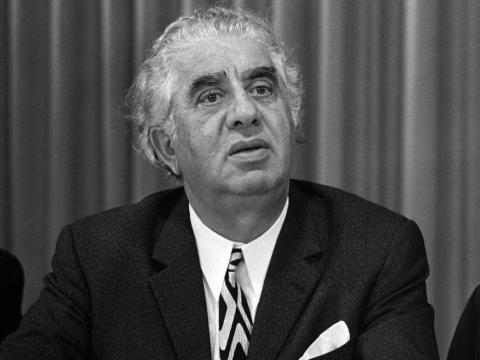You are here
An Armenian National Treasure
Aram Khachaturian is an Armenian national treasure. He was born to an Armenian family in Tbilisi, Georgia, in 1903 and is considered a leading composer of the Soviet Union. According to music historian Harlow Robinson, "his proletariat origins, non-Russian ethnic origins, and Soviet training [made him] a powerful symbol within the Soviet musical establishment.”
Khachaturian is celebrated by the Armenian people "as a famous son who earned worldwide recognition." He was the most renowned Armenian composer of the 20th century and the most famous representative of Soviet Armenian culture. He has been described as the "Armenian Tchaikovsky,” and musician Sahan Arzruni has called him "the musical ambassador of Armenian culture."
According to Khachaturian: I grew up in an atmosphere rich in folk music: popular festivities, rites, joyous and sad events in the life of the people always accompanied by music, the vivid tunes of Armenian, Azerbaijani and Georgian songs and dances performed by folk bards and musicians — such were the impressions that became deeply engraved on my memory, that determined my musical thinking. They shaped my musical consciousness and lay at the foundations of my artistic personality... Whatever the changes and improvements that took place in my musical taste in later years, their original substance, formed in early childhood in close communion with the people, has always remained the natural soil nourishing all my work.
Khachaturian moved to Moscow in 1921 following the Sovietization of the Caucasus. Without prior music training, he enrolled in the Gnessin Musical Institute and subsequently the Moscow Conservatory. He later taught at both of these institutions, and as a university professor, Khachaturian emphasized the role of folk music to his students and instilled the idea that composers should master their nations' folk music heritage.
At the concert, we will bring you four pieces from Khachaturian’s ballet, Gayane: “Young Maidens,” “Awakening and Dance,” “Sabre Dance,” and “Hopak.” The ballet includes themes of interethnic love, betrayal, and friendship that interact in an Armenian setting. The central character is a young woman named Gayane, who works in a kolkhoz (a collective farm) in a mountainous district near the national border.
"Sabre Dance" is Khachaturian's best-known and most recognizable work. It has been featured in film and television and has been used as performance music by several high-profile figure skaters from at least five countries. In 1948, it was recorded by popular singers and became an immediate jukebox hit. Later, it was played by many well-known performers, including The Boston Pops, Liberace, and rock bands The Pretenders and Cheap Trick.
We had prepared these four Khachaturian dances for you in March 2020, but the performance was canceled just three days prior due to the onset of the COVID-19 pandemic. The symphony is excited to finally bring you this performance, full of delight and artistry.
